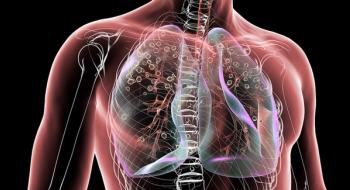
Disparities in Pneumonia and Fibrosis Mortality Persist Across the US
Key Takeaways
- Mortality rates for pneumonia and pulmonary fibrosis have declined since 1999, but disparities persist by sex, race, and region.
- The COVID-19 pandemic caused a temporary spike in mortality rates, particularly affecting high-risk populations.
A national analysis of CDC data over 25 years revealed persistent sex, racial, and regional disparities in pneumonia and pulmonary fibrosis mortality.
A new population-based analysis of United States mortality data from the CDC Wide-Ranging Online Data for Epidemiologic Research (CDC WONDER) platform shows that, while deaths related to pneumonia and pulmonary fibrosis have declined overall since 1999, marked disparities persist by sex, race, and geographic region. The findings, presented at
Pneumonia and pulmonary fibrosis represent overlapping respiratory conditions linked through inflammatory and fibrotic pathways in the lung. Pneumonia causes acute inflammation and infection of the alveoli, whereas
Researchers examined US death certificate data, identifying multiple causes of death coded for pneumonia (ICD-10 J18) and pulmonary fibrosis (ICD-10 J84). Age-adjusted mortality rates (AAMRs) per 100,000 persons and annual percent change (APC) were calculated and stratified by age group, sex, race/ethnicity, and census region. In total, 78,127 deaths were attributed to pneumonia and pulmonary fibrosis combined during the 25-year study period.
Nationally, the AAMR declined from 0.99 in 1999 to 0.69 in 2019, likely reflecting decades of progress in vaccination coverage, antimicrobial therapy, and management of chronic comorbidities. However, mortality sharply increased to 1.36 in 2021, coinciding with the peak of the COVID-19 pandemic, before falling again to 0.90 by 2023. Investigators attributed the transient increase to excess respiratory deaths during the pandemic, when COVID-related pneumonia and postinfectious pulmonary fibrosis were common.2 This pattern mirrors national excess-mortality trends reported by the National Bureau of Economic Research and CDC surveillance.3
Across the full study period, males consistently had higher AAMRs than females.1 In men, rates declined from 1.31 in 1999 to 0.92 in 2018 (APC: –3.2%), spiked to 1.75 in 2021 (APC: 24.6%), and then dropped to 1.13 in 2023. Among women, AAMRs fell from 0.81 to 0.61 over the same baseline period (APC: –2.7%), then increased to 1.04 in 2021 (APC: 20.2%), and stabilized at 0.72 in 2023. Prior studies have documented a higher prevalence of pulmonary fibrosis and worse survival in men, potentially linked to differences in occupational exposures, smoking history, and lung anatomy.4,5
Non-Hispanic American Indian/Alaska Native populations had the highest mortality burden, peaking at 3.03 deaths per 100,000 in 2009 and again rising to 2.22 in 2020 after years of decline.1 Among non-Hispanic Black individuals, AAMR dropped from 0.67 in 1999 to 0.48 in 2018 before increasing to 0.71 in 2020. Hispanic/Latino populations followed a similar pattern, dropping from 1.28 to 1.01 before increasing to 1.49 in 2020. These shifts parallel broader evidence that AI/AN and Hispanic communities experienced disproportionate respiratory mortality during the pandemic, reflecting higher infection exposure and reduced access to specialty pulmonary care.6
Regionally, the South exhibited the highest burden, with AAMR declining from 0.99 in 1999 to 0.79 in 2018, peaking at 1.49 in 2021, and falling to 0.94 in 2023. Similar but less pronounced trends occurred in the Midwest, Northeast, and West. These variations may relate to regional differences in smoking prevalence, environmental exposures, and health-system capacity.7
Although mortality rates have generally improved over the last 2 decades, demographic and geographic inequities remain. Investigators stressed that, “Despite improvements, disparities persist, requiring targeted interventions.”
References
- Ahmad A, Khan S, Ahmad A, Ahmad J, Irtaza A, and Ahmad J. Trends in pneumonia and pulmonary fibrosis-related mortality in the United States (1999-2023): insights from CDC WONDER. Presented at: CHEST 2025; October 19-22, 2025; Chicago, IL.
- Leary C, Bine C, Baral N, et al. Trends in interstitial lung disease and the COVID-19 pandemic in the United States from 1999 to 2022. Respir Res. 2025;26(1):277. doi:10.1186/s12931-025-03350-2
- National Bureau of Economic Research. Excess Mortality during the COVID-19 pandemic. NBER. Published March 8, 2022. Accessed October 28, 2025.
https://www.nber.org/bh-20221/excess-mortality-during-covid-19-pandemic - Sesé L, Nunes H, Cottin V, et al. Gender differences in idiopathic pulmonary fibrosis: are men and women equal? Front Med. 2021;8:713698. doi:10.3389/fmed.2021.713698
- Zaman T, Moua T, Vittinghoff E, Ryu JH, Collard HR, Lee JS. Differences in clinical characteristics and outcomes between men and women with idiopathic pulmonary fibrosis: a multicenter retrospective cohort study. Chest. 2020;158(1):245-251. doi:10.1016/j.chest.2020.02.009
- Ward LA, Black KP, Britton CL, Tompkins ML, Provost EM. COVID-19 cases, hospitalizations, and deaths among American Indian or Alaska Native persons - Alaska, 2020-2021. MMWR Morb Mortal Wkly Rep. 2022;71(22):730-733. doi:10.15585/mmwr.mm7122a2. Accessed October 29, 2025.
https://www.cdc.gov/mmwr/volumes/71/wr/mm7122a2.htm - National Center for Health Statistics. Chronic Lower Respiratory Disease Mortality | Stats of the States. Centers for Disease Control and Prevention. Published August 20, 2025. Accessed October 29, 2025.
https://www.cdc.gov/nchs/state-stats/deaths/respiratory-disease.html
Newsletter
Stay ahead of policy, cost, and value—subscribe to AJMC for expert insights at the intersection of clinical care and health economics.














































